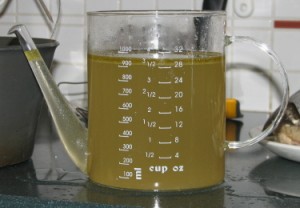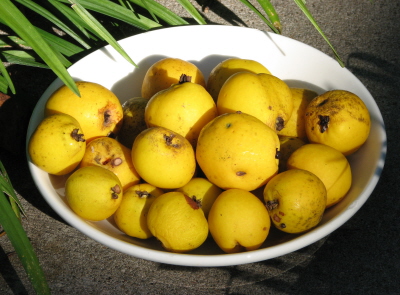When life gives you green tomatoes, you might as well make Green Tomato Cake and Green Tomato Chutney. Some people would also make Green Tomato Pickles. I probably should have. Here, in any case, is the story.
The setup
Sure, I told my sister. I’ll take some of your green tomatoes. Don’t just throw them out. Yea, I guess I could take about 5 pounds. The delivery (which arrived with the red ribbon) instead was one overflowing peck, a little more than double what I expected:

A bucket full of green tomatoes
The ‘solution’
First up, Green Tomato Cake, using 4 cups (about 2 pounds) of minced green tomatoes. I made very few changes, but here’s what I did.
Green Tomato Cake
- 4 cups (about 2 pounds) chopped green tomatoes (I used the food processor)
- 1 tablespoon salt plus 1/4 teaspoon salt, divided
- 1/2 cup butter, softened
- 2 cups sugar
- 2 eggs
- 2 cups all-purpose flour
- 1 teaspoon ground cinnamon
- 1 teaspoon ground nutmeg
- 1 teaspoon baking soda
- 1/4 cup raisins, chopped (see note)
- 1/2 cup chopped walnuts

- Place chopped tomatoes in a bowl and sprinkle with 1 tablespoon salt. Let stand 10 minutes. Place in a colander, rinse with cold water and drain.
- Cream butter and sugar. Add eggs and beat until creamy.
- Add flour, cinnamon, nutmeg, soda and 1/4 teaspoon salt. Mix well.
- Add raisins, walnuts and drained tomatoes. Mix well.
- Transfer batter into greased and floured 10-inch tube pan or 9 x 13 inch pan.
- Bake 40 to 45 minutes in the 350-degree oven, or until toothpick inserted into cake comes out clean.
- If using tube pan, allow to cool 10-15 minutes in pan, then place plate over pan and invert cake onto plate. (Leave cake in 9 x 13 pan to cool.)
- When thoroughly cool, dust with powdered sugar or frost, if desired, with cream-cheese frosting and serve. Makes 20 servings.
Note: I chopped the raisins in expectation that my sister, the giver of the tomatoes and the to-be recipient of the cake, would turn her nose up at raisins. But I wanted them in for the flavor, so I chopped them. She hasn’t complained.

The verdict: Nice, moist spice cake, reminiscent of zucchini or carrot cake except for those pale green flecks. (You’ll notice I didn’t do a bang-up job unmolding (depanning?) the thing, but that doesn’t affect the taste!)

The other 8 pounds
Cake done, that left a mere 8 pounds of green tomatoes, which meant I didn’t have enough of some ingredients to make Green Tomato Chutney. I didn’t let that stop me. I’ll spare you the recipe of what I actually made, though, because to my taste buds I wound up with something akin to sweet pickle relish. Twelve pints of sweet pickle relish. Twelve pints of odd sweet pickle relish. (Hmm…is that, um, ginger in this relish?)
I have from now till Christmas to think of things to do this stuff, because everybody I know is getting it for a present. So that they don’t chuck it, I’ve got to come up with some uses. If you’ve got some ideas, LET ME KNOW!!
Meanwhile, I’m thinking this relish just may have cured me of my say-yes-to-free-food impulses, at least for the moment…

Yes, there are three pints more than the nine in this picture...


















